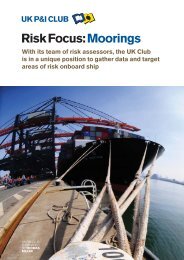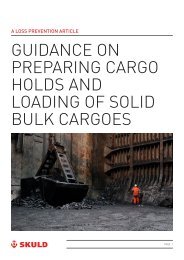You also want an ePaper? Increase the reach of your titles
YUMPU automatically turns print PDFs into web optimized ePapers that Google loves.
<strong>ECSA</strong><br />
<strong>The</strong> <strong>Tramp</strong> <strong>Shipping</strong> <strong><strong>Mar</strong>ket</strong><br />
14.4 Pool arrangements<br />
One of the most common arrangements for working together in the shipping industry is the<br />
"Pool". <strong>Shipping</strong> pools are currently used in almost all segments of the tramp/non-liner shipping<br />
market including products tanker business, the chemical tanker business, the LPG business, the<br />
bulk carrier business and the crude tanker business. Recently established pools include a capesize<br />
bulker pool of over a hundred vessels, while in the tanker sector, at least 20% of VLCCs are<br />
understood to be in a pool, and almost a third of all long and mid-range product tankers (this<br />
includes all product tankers larger than 45,000 dwt in size).<br />
A shipping pool can be defined as “a collection of similar vessel types under various ownerships<br />
placed in the care of a central administration” 17 . Areas of potential co-operation are shown in<br />
table 5. Pools are generally developed for 2 reasons. Firstly to allow participants to provide the<br />
service levels required by their major customers. Secondly, to improve transport efficiency by<br />
special investment and increased ship utilisation e.g. by arranging backhaul cargoes more<br />
effectively than a small group of ships could do.<br />
14.5 Space Charter Agreements<br />
In the breakbulk era liner companies operated freight pools, particularly in thin trades, in order to<br />
spread operational costs. Containerisation saw the introduction of consortia (sharing<br />
administrative and operating costs and revenue) and alliances (sharing vessel operating costs) as<br />
carriers sought to drive down operating costs and increase vessel size to access scale. Vessel<br />
sharing agreements, today’s most common format, operate on the basis of slot swaps between<br />
participating carriers with inequalities of provision and usage settled by cash cross-payments at<br />
pre-determined prices. In addition, carriers sell slots to third parties, to competing lines without<br />
sufficient market support to start their own services, and to lines seeking to supplement their own<br />
service capacity as well as to container leasing companies seeking to reposition empty containers.<br />
Slot charters are generally on the basis of long term inter-line contractual arrangements, with slot<br />
prices set for a fixed duration, but the slot prices for spot arrangements are fixed ad hoc. Needless<br />
to say, carriers prefer to restrict slot sales to capacity that they cannot themselves make profitable<br />
use of. Instances in which space is subcontracted to cargo interests are extremely rare or nonexistent.<br />
Space charter arrangements also exist in some of the specialised sectors. Considering the<br />
customer structure and the service requirements they place on the carriers it is a need to optimise<br />
capacity utilisation, sailing frequencies and port coverage to the benefit of the customers. Carriers<br />
use both irregular ad hoc space charter arrangements mainly to cover short term fluctuations as<br />
well as more regular fixed positioning space charters.<br />
17 William V. Packard 1989 <strong>Shipping</strong> Pools, Lloyds of London Press Ltd, London p 5<br />
Clarkson Research Services Limited 33 <strong>Mar</strong>ch <strong>2015</strong>




